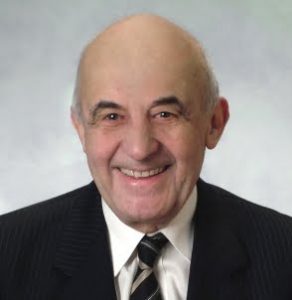György Szakolczai
From 1949 to 1951, he worked as an administrator at Agrimpex and then at Terimpex Foreign Trade Company. Between 1951 and 1957, he was a machine fitter at MÁVAG Locomotive and Machine Factory.
He worked as a freelance translator between 1957 and 1958. It was during this time that he published his articles on the input-output method and his translation of Tinbergen's book "Econometrics".
From 1958 to 1962, he was an employee of the Market and Economic Research Department of the Hungarian Chamber of Commerce. He dealt with international economic issues and wrote information for business leaders on the actual and expected economic situation abroad. He published his collection of articles entitled “The Conditions of Economic Development” in due time.
From 1963 to 1990, he was the head of the Econometrics Laboratory belonging to various computer science and economics institutions. The Laboratory first belonged to the Computer Center of the Ministry of Heavy Industry (NIM), then to the Information Processing Laboratory (Infelor), and its successor, the Computer Applications Research Institute (Számki), and was the first in Hungary to use computer tools to solve economic problems. At the beginning of this period, he completed and published his collection of articles entitled “The Conditions of Economic Growth”. Prior to this, the focus of his professional work was on the introduction and acceptance of modern mathematical methods, which had been rejected in our country until then, and then the modern theory of economic development and growth. In the Econometrics Laboratory, he already dealt with the theoretical and computational support of progressive economic policy efforts in Hungary, including the reform of the economic mechanism, using these tools.
In 1979 he was a visiting professor at the University of Texas at Austin. He lectured on the principles, practice and reform efforts of socialist economics to undergraduate and postgraduate students; he gave about ten lectures on the same subject at leading American universities. In 1984 he was a visiting researcher at Princeton University, where he compared American and Hungarian economics education.
In 1990-1994, as a ministerial advisor to the Ministries of Welfare and Foreign Trade, he prepared proposals for solving current issues.
Between 1991 and 1993, he was an invited lecturer at the Budapest University of Technology (BME), and from 1993 until his retirement in 1998, he was a professor at BME. He gave basic economics lectures to civil engineering students.
Between 1998 and 2015, he taught at the General College of Entrepreneurship (ÁVF) as a professor emeritus. He lectured on macroeconomics, microeconomics, and economic development theory.
From 1990, he dealt with economic policy and economic theory issues. Until 2005, he primarily sought solutions to the economic policy problems of the time and wrote publications on this topic. He returned to scientific activity in 2005. He published several books and a large number of scientific articles, as well as some publications. By 2019, he had published more than 300 publications.
In 1974, he received the scientific degree of Candidate of Sciences of the Hungarian Academy of Sciences. In 1996, he habilitated at the Budapest University of Economics (BKE). In 2017, he was elected a full member of the Szent István Academy of Sciences. Based on his book on macroeconomics published in 2018 (see below), he received the title of Doctor of Sciences of the Hungarian Academy of Sciences in 2020.
His awards: Széchenyi Medal (Hungarian Economic Society, MKT, 1971); Officer's Cross of the Hungarian Order of Merit (2012).
- scienfitic CV
- announcements
György Szakolczai: The Econometric Laboratory. In: THE ACCOUNTANT and its Predecessors (compiled and edited by Miklós Havass), Budapest, Szamalk Publishing House, 2011, pp. 95-98.
György Szakolczai: John Maynard Keynes, the Keynesian system of the international economy and the International Monetary Fund. Budapest, Economic Review Foundation, 2018. 420 pages. ISBN 9789638976932.
- He has five children, nine grandchildren, and one great-grandchild. (2020 announcement.)
- He was a member of Christian-socialist movements from 1943. He participated in the resistance movement in 1944. In 1998 he received the Barankovics Memorial Medal from the Christian Democratic People's Party (KDNP).
Created: 2020.01.24. 11:13
Last modified: 2024.10.25. 13:09

